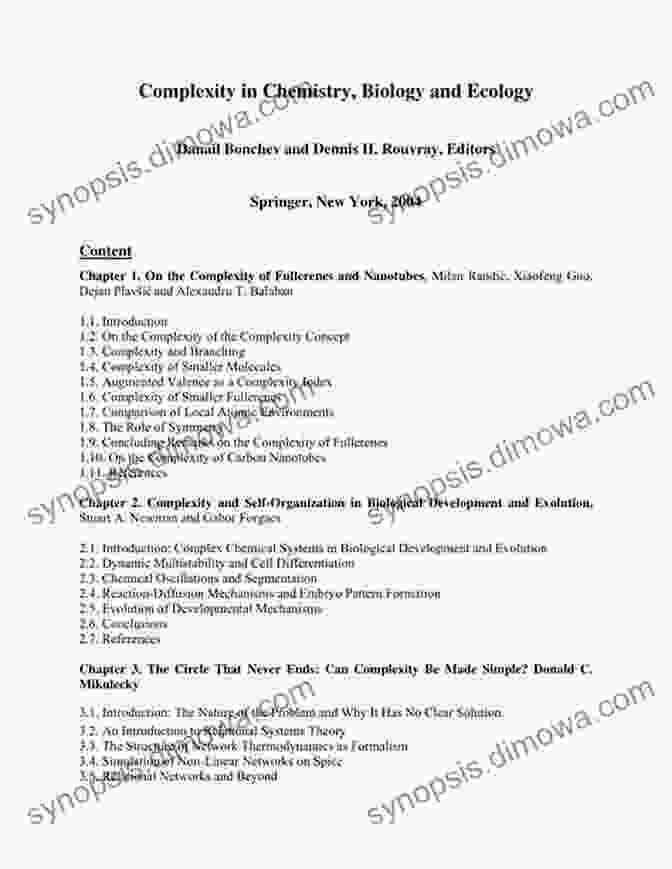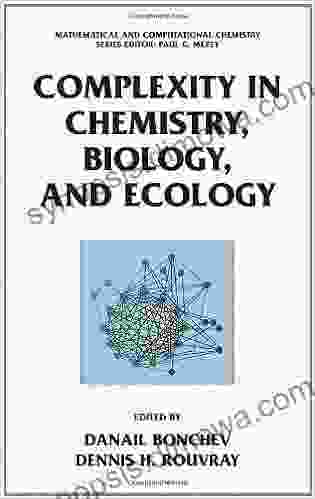Complexity in Chemistry, Biology, and Ecology: A Mathematical and Computational Journey


5 out of 5
| Language | : | English |
| File size | : | 4786 KB |
| Text-to-Speech | : | Enabled |
| Screen Reader | : | Supported |
| Word Wise | : | Enabled |
| Print length | : | 368 pages |
| Paperback | : | 244 pages |
| Item Weight | : | 1.27 pounds |
| Dimensions | : | 8.5 x 0.51 x 11 inches |
Complexity is a ubiquitous phenomenon in the natural world. From the intricate interactions of molecules in chemical reactions to the dynamics of ecological communities, complexity manifests in a myriad of ways. Understanding and unraveling these complexities is a grand challenge for modern science. This book takes an interdisciplinary approach to exploring complexity in chemistry, biology, and ecology, utilizing mathematical and computational tools to gain novel insights into these fascinating systems.
Chapter 1: Complexity in Chemical Systems
This chapter explores the complexities encountered in chemical systems, including molecular dynamics, reaction networks, and self-assembly. Through mathematical modeling and computer simulations, researchers seek to understand the emergent properties and behaviors that arise from the interactions of individual molecules.
Molecular Dynamics
Molecular dynamics simulations provide a powerful tool for studying the dynamics of molecules at the atomic level. By numerically solving the equations of motion, researchers can simulate the behavior of molecules in various environments, providing insights into their structure, function, and interactions.
Reaction Networks
Chemical reactions occur in complex networks, where multiple reactions take place simultaneously. Understanding these networks is crucial for predicting the outcome of chemical processes. Mathematical modeling and computation enable researchers to analyze and predict the behavior of reaction networks, including their stability, reactivity, and sensitivity to changes.
Self-Assembly
Self-assembly is a process by which molecules spontaneously organize into complex structures. This phenomenon plays a vital role in biological systems, such as the formation of proteins and DNA. By combining mathematical theory and computational simulations, researchers aim to unravel the principles governing self-assembly and harness it for the design of new materials and technologies.
Chapter 2: Complexity in Biological Systems
Biological systems exhibit immense complexity, from the intricate structure and function of cells to the dynamics of ecosystems. This chapter investigates the use of mathematical and computational tools to understand these complexities, focusing on areas such as gene regulation, protein-protein interactions, and evolutionary dynamics.
Gene Regulation
Gene regulation is a complex process that controls the expression of genes in response to various stimuli. Mathematical models and computational simulations allow researchers to analyze and predict the behavior of gene regulatory networks, gaining insights into how cells respond to their environment and maintain homeostasis.
Protein-Protein Interactions
Proteins interact with each other to form complex networks that carry out essential cellular functions. Understanding these interactions is vital for unraveling the molecular basis of biological processes. Computational methods, such as docking and molecular dynamics simulations, enable researchers to study protein-protein interactions at the atomic level.
Evolutionary Dynamics
Evolutionary dynamics describe the changes in populations over time. Mathematical and computational models provide tools for simulating and analyzing evolutionary processes, including the effects of selection, drift, and mutation. These models help researchers understand the mechanisms driving evolution and predict the future trajectory of populations.
Chapter 3: Complexity in Ecological Systems
Ecological systems are characterized by complex interactions among species and their environment. This chapter explores the use of mathematical and computational approaches to study ecological dynamics, including population ecology, food webs, and ecosystem modeling.
Population Ecology
Population ecology investigates the dynamics of populations in response to various factors, such as birth rates, death rates, and environmental carrying capacity. Mathematical models and simulations enable researchers to predict population growth, stability, and extinction risk.
Food Webs
Food webs describe the feeding relationships between species in an ecosystem. Computational models help researchers analyze the stability and resilience of food webs, identifying keystone species and predicting the consequences of species loss.
Ecosystem Modeling
Ecosystem modeling aims to capture the complex interactions within ecosystems. These models integrate information on species abundance, energy flow, and environmental factors to simulate ecosystem dynamics and predict the effects of human activities and environmental changes.
Applications and Future Directions
The understanding of complexity in chemistry, biology, and ecology has far-reaching implications for various fields. In medicine, it aids in the development of personalized therapies and the prediction of drug interactions. In biotechnology, it assists in the design of novel biomaterials and the optimization of industrial processes. In environmental science, it enables the prediction of climate change impacts and the development of conservation strategies.
Future research directions in complexity science include the integration of machine learning and artificial intelligence, the development of new mathematical techniques for modeling complex systems, and the exploration of the role of complexity in emerging fields such as systems biology and synthetic biology.
This book provides a comprehensive overview of the latest advancements and insights into the field of complexity in chemistry, biology, and ecology. By combining mathematical and computational approaches, researchers are unraveling the intricacies of these complex systems, gaining unprecedented insights into their behavior and dynamics. This knowledge has the potential to transform various fields and address some of the most pressing challenges facing society, including climate change, disease prevention, and sustainable resource management.
For researchers, students, and professionals interested in complexity science, this book is an essential resource that offers a deep dive into the interdisciplinary exploration of complex systems. It will inspire and guide future research endeavors, fostering a deeper understanding of the intricate workings of the natural world.
5 out of 5
| Language | : | English |
| File size | : | 4786 KB |
| Text-to-Speech | : | Enabled |
| Screen Reader | : | Supported |
| Word Wise | : | Enabled |
| Print length | : | 368 pages |
| Paperback | : | 244 pages |
| Item Weight | : | 1.27 pounds |
| Dimensions | : | 8.5 x 0.51 x 11 inches |
Do you want to contribute by writing guest posts on this blog?
Please contact us and send us a resume of previous articles that you have written.
 Book
Book Novel
Novel Page
Page Chapter
Chapter Text
Text Story
Story Genre
Genre Reader
Reader Library
Library Paperback
Paperback E-book
E-book Magazine
Magazine Newspaper
Newspaper Paragraph
Paragraph Sentence
Sentence Bookmark
Bookmark Shelf
Shelf Glossary
Glossary Bibliography
Bibliography Foreword
Foreword Preface
Preface Synopsis
Synopsis Annotation
Annotation Footnote
Footnote Manuscript
Manuscript Scroll
Scroll Codex
Codex Tome
Tome Bestseller
Bestseller Classics
Classics Library card
Library card Narrative
Narrative Biography
Biography Autobiography
Autobiography Memoir
Memoir Reference
Reference Encyclopedia
Encyclopedia David Conway
David Conway Jennifer L Rohn
Jennifer L Rohn Deanna Rutledge
Deanna Rutledge Tim Hayden
Tim Hayden Deepa Agarwal
Deepa Agarwal Magdalena Matulewicz
Magdalena Matulewicz Lisa Doan
Lisa Doan Mildred T Walker
Mildred T Walker David Simchi Levi
David Simchi Levi Dominic Mchugh
Dominic Mchugh Hab Publication
Hab Publication Peter H Gleick
Peter H Gleick David Podlipny
David Podlipny Martina Sylvia Khamphasith
Martina Sylvia Khamphasith Eckehard W Mielke
Eckehard W Mielke Dean Maccannell
Dean Maccannell Ewan Phillips
Ewan Phillips David T Holmstrom
David T Holmstrom Lucas Weber
Lucas Weber Paul Blakey
Paul Blakey
Light bulbAdvertise smarter! Our strategic ad space ensures maximum exposure. Reserve your spot today!
 Kevin TurnerFollow ·19.3k
Kevin TurnerFollow ·19.3k Anton ChekhovFollow ·10.4k
Anton ChekhovFollow ·10.4k Chuck MitchellFollow ·6k
Chuck MitchellFollow ·6k Jerome PowellFollow ·2.8k
Jerome PowellFollow ·2.8k W.H. AudenFollow ·7.6k
W.H. AudenFollow ·7.6k Percy Bysshe ShelleyFollow ·8.5k
Percy Bysshe ShelleyFollow ·8.5k Kenzaburō ŌeFollow ·10.5k
Kenzaburō ŌeFollow ·10.5k E.M. ForsterFollow ·2.8k
E.M. ForsterFollow ·2.8k

 Aron Cox
Aron CoxMastering Project Management: The Ultimate Guide to...
In today's competitive...

 Dominic Simmons
Dominic SimmonsLet's Build Sue Fliess: Unleash the Polychrome Master...
Chapter 1: The...

 Mason Powell
Mason PowellMaster the Digital Marketing Landscape: Fundamentals of...
In the age of digital...

 Aubrey Blair
Aubrey BlairUncover the Secrets of Ancient Blades and Enchanting...
Embark on an Enchanting Journey into the...

 Shannon Simmons
Shannon SimmonsUnleash the Spooktacular with Spooky Crochet Tutorials...
Prepare to be spooked...

 Cade Simmons
Cade SimmonsImmerse Your Little Ones in a World of Enchantment with...
Nursery rhymes have forever ignited the...
5 out of 5
| Language | : | English |
| File size | : | 4786 KB |
| Text-to-Speech | : | Enabled |
| Screen Reader | : | Supported |
| Word Wise | : | Enabled |
| Print length | : | 368 pages |
| Paperback | : | 244 pages |
| Item Weight | : | 1.27 pounds |
| Dimensions | : | 8.5 x 0.51 x 11 inches |












